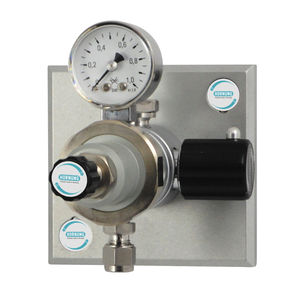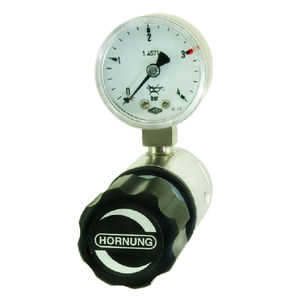
Propane pressure regulator HP 456for compressed airfor gasheated gas


Add to favorites
Compare this product
Characteristics
- Product
- for oxygen, for compressed air, for gas, for inert gases, for nitrogen, for sour gas, heated gas, propane, for CO2, for hydrogen, for acetylene, for natural gas, for CNG
- Technology
- diaphragm
- Number of stages
- single-stage
- Material
- chrome-plated brass, stainless steel
- Applications
- industrial, for medical applications, for analytical instruments, high-purity, for chromatography, low-pressure
- Other characteristics
- compact, with pressure gauge, high-purity, medium-flow, for low flow rates, with flow measurement system
- Pressure
Max.: 40 bar
(580.15 psi)Min.: 0 bar
(0 psi)- Orifice diameter
0.25 in
- Temperature
Max.: 70 °C
(158 °F)Min.: -20 °C
(-4 °F)
Description
The HP 456 point of use regulator is fitted with a diaphragm shut-off valve, single-stage pressure regulator and a flow measurer and a dosage valve.
The point of use regulator HP 456 is an sys- tem wall version.
The point of use regulator is ready mounted on a console and is connected to a permanen- tly laid piping system.
It serves as a second stage and reduces the line pressure to an adjustable working pres- sure. A floating body in the measuring tube shows the flow rate on a scale.
The HP 456 is designed for low pressure use.
It is used where an exact dosage and reading of this dosage on a scale is required.
Especially for gases with high requirements on purity to 6.0. secure and leak proof.
Through our special cleaning system our pressure regulators are suitable for ECD – applications.
Catalogs
high purity gas control equipment
218 Pages
Druckgastechnik Produktübersicht
20 Pages
Hydrogen Sonderheft 2023
20 Pages
Exhibitions
Meet this supplier at the following exhibition(s):

Other Hornung GmbH products
Point of use regulator for high purity gases
Related Searches
- Valve
- Hand valve
- Stainless steel valve
- Threaded valve
- Regulating valve
- Stop valve
- Valve with handwheel
- Pressure limiter
- Biogas valve
- Single-stage regulator
- Valve for industrial applications
- Valve for the chemical industry
- Nickel-plated brass valve
- Industrial regulator
- Radial diaphragm valve
- Diaphragm pressure regulator
- Compact valve
- Metal pressure regulator
- Industrial valve
- Valve for the food industry
*Prices are pre-tax. They exclude delivery charges and customs duties and do not include additional charges for installation or activation options. Prices are indicative only and may vary by country, with changes to the cost of raw materials and exchange rates.











